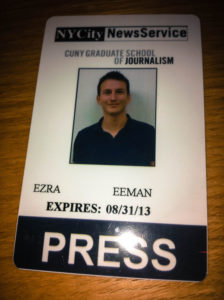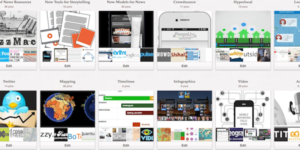 The news environment today is complex and poses many challenges. On a day to day basis news makers don’t have time to rethink the way they work. Taking a step back is essential. The Fulbright Journalism Grant allowed me to do so.
The news environment today is complex and poses many challenges. On a day to day basis news makers don’t have time to rethink the way they work. Taking a step back is essential. The Fulbright Journalism Grant allowed me to do so.
I applied to the CUNY Graduate School of Journalism because it is pioneering in the field of ‘Entrepeneurial Journalism’. I wanted to focus on developing new business models for news and understand the changes brought by new technologies and shifting consumer patterns. At the same time I wanted to explore the new tools and storytelling platforms hands-on.
Working closely with Professor Jeff Jarvis and Jeremy Caplan of the Entrepreneurial Journalism department I learned about the key forces in the media business today and I tried to identify new opportunities. In order to understand the start-up process we developed ‘Buur.t’ a new hyper local news platform providing news and government data on a neighborhood level to the top 12 cities in Flanders. In doing so we explored the dynamics of hyper local news, did initial market research, considered revenue streams and finances and worked towards a final proposal and pitch for an audience of investors. During the same period I also had the chance to explore tools for data-visualization and multimedia journalism together with Russell Chun and Amanda Hickman. This resulted in two compelling and interactive news publications for the New York City News Service.
Gaining insights in the new dynamics of news over a time span of just a couple of months is not an easy feat. I could have used some additional time to digest all the information. I came to  realise that adapting to a world where the people formerly known as the audience are not readers and viewers but users and publishers will mean changing not just tactics but also self-conception. Merely bolting on a few new techniques will not be enough to adapt to the changing ecosystem.
realise that adapting to a world where the people formerly known as the audience are not readers and viewers but users and publishers will mean changing not just tactics but also self-conception. Merely bolting on a few new techniques will not be enough to adapt to the changing ecosystem.
Taking advantage of access to individuals, crowds and machines will mean changing organizational structure as well. Some additional research is necessary to explore these challenges.
T he foremost extra-curricular activity that took almost all of my spare time was the Presidential Election. I attended lectures on the history of the presidential debate, went to political neighbourhood meetings and travelled to Washington to talk to the Belgian Ambassador to gain more insight in the election process. Experiencing this first-hand was a unique opportunity. I also took the opportunity to write several articles and online-publications for the New York News Service that is affiliated with CUNY. These articles covered a wide range of topics: the economics of the NYC greenmarkets, the insurance problems of FEMA and the geographic distribution of homeless veterans.
he foremost extra-curricular activity that took almost all of my spare time was the Presidential Election. I attended lectures on the history of the presidential debate, went to political neighbourhood meetings and travelled to Washington to talk to the Belgian Ambassador to gain more insight in the election process. Experiencing this first-hand was a unique opportunity. I also took the opportunity to write several articles and online-publications for the New York News Service that is affiliated with CUNY. These articles covered a wide range of topics: the economics of the NYC greenmarkets, the insurance problems of FEMA and the geographic distribution of homeless veterans.
For the moment I’m back at VTM News in Belgium where I will see how I can implement my new gained knowledge and experience. Starting a news innovation hub is one of my priorities. At the same time I will pitch my hyper local news platform to some of the big media groups in Flanders. If you want to read a blog that I maintained while I was in the U.S., feel free to check it out here: http://www.unionstreet674.net/.
Ezra Eeman
The Fulbright-Hays Journalism grant began in 1983-84 to foster mutual understanding between the United States and Belgium via journalists, who the Commission believes to be critical supporters of a democratic society. To date, the Commission has sponsored around 30 journalists from the French and Flemish-speaking communities of Belgium to travel to the United States to study and research issues in Journalism with this $30,000 award. Our alumni currently work at premier news outlets throughout Belgium. To apply, submit a preliminary application here: https://www.fulbright.be/fulbright-awards/application-form/